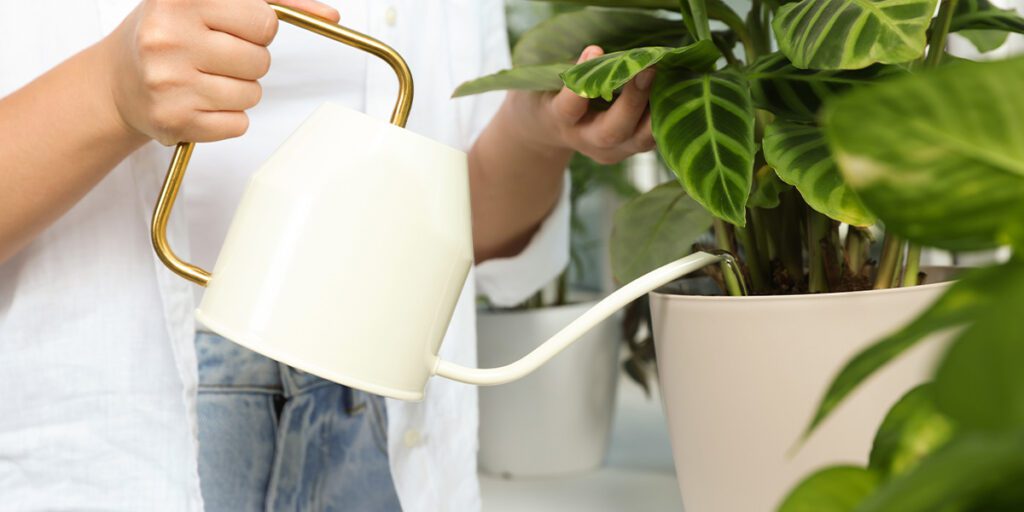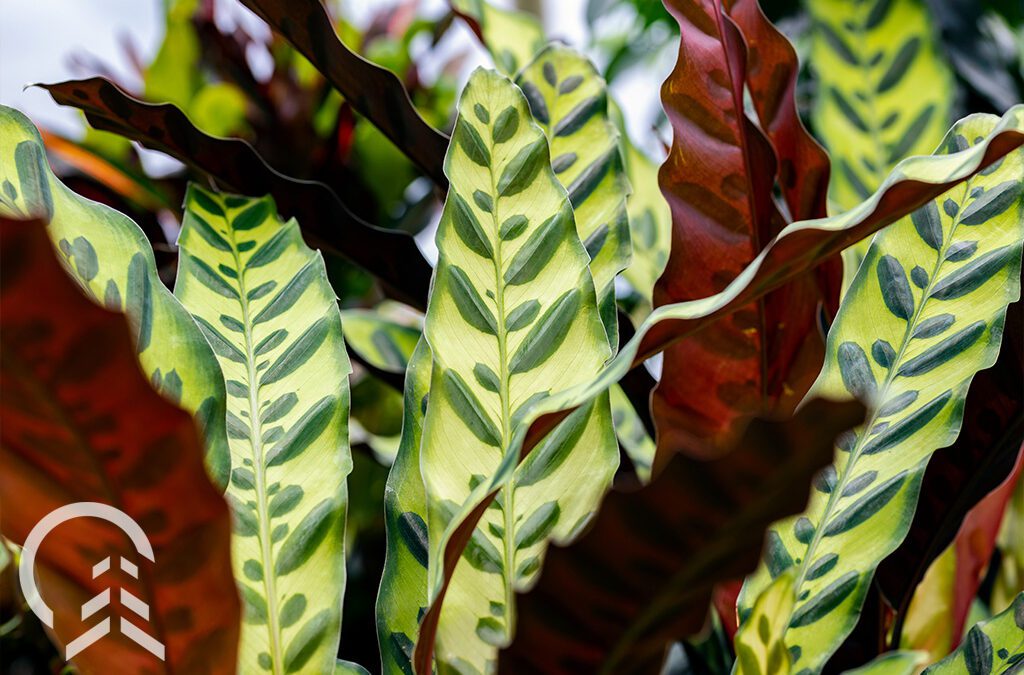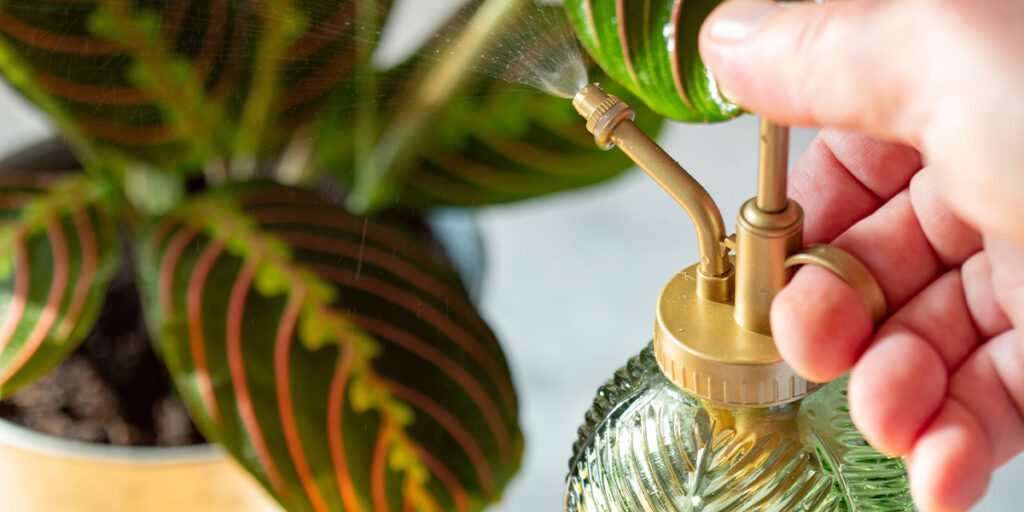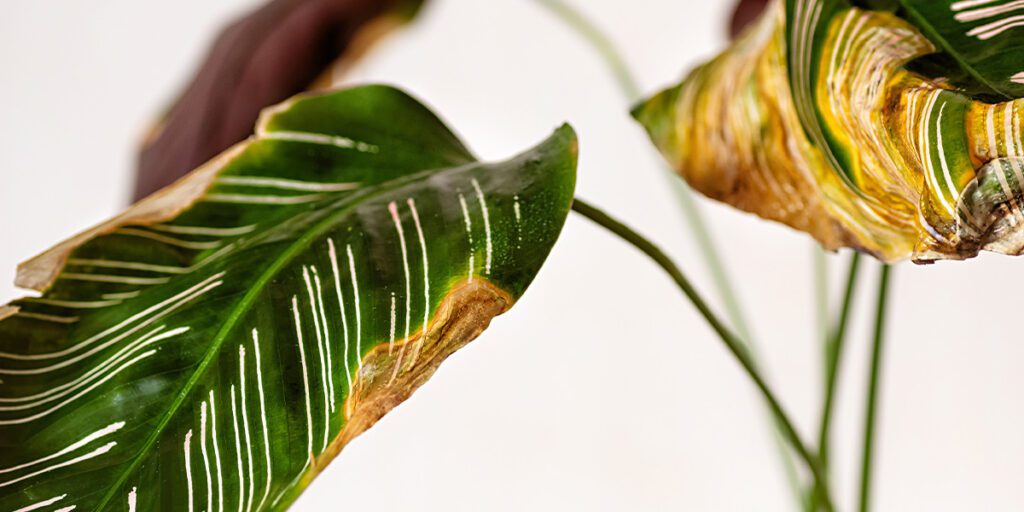With bold, colorful, and highly patterned leaves, calatheas are some of the most beautiful houseplants around. They’re also part of the larger “prayer plants” family, named for the way they fold their leaves together at night. Although calatheas can be finicky at times, once you know how to properly care for them, it’s easy to maintain and enjoy these tropical beauties—here’s how!
Give Them Lots of Bright, Indirect Light
Like many tropical houseplants, calatheas naturally grow on the forest floor beneath the jungle’s canopy. As a result, they’ve adapted to thrive with bright, indirect sunlight. Inside your house, you can recreate this setting by placing them near an east-, west-, or south-facing window, but not too close! Direct sunlight can scorch their leaves, so it’s best to either set them up behind a sheer curtain or place them a little ways back from the window. They also tolerate low, indirect light if that’s all you have available.

Keep Them Moist, But Not Soggy
You’ve probably heard this saying many times before, but what exactly does “moist but not soggy” mean? For calatheas, it’s a reminder of the delicate balance you need to maintain with your watering. You don’t want to let the soil dry out completely, but you also don’t want to water them too much, as overwatering calatheas causes much more damage than underwatering. It’s best to check your calathea’s moisture once per week by sticking your finger into the soil. If it feels dry, it’s time to water. If it’s still damp, wait a few days and test it again.
Maintain Tropical Temperatures
Calatheas are used to growing in the tropics, not the Midwest. Thankfully, the conditions inside our homes remain more or less tropical year-round. Still, you want to be mindful of their needs and keep them in especially warm spots, as they thrive in temperatures between 75-80 degrees and can’t tolerate dips below 60.

Keep Them Humid
Calatheas are quite fond of higher humidity levels, thriving at 50% humidity or more. Again, however, this doesn’t always translate very well to our Midwest homes. Sometimes, our indoor air’s moisture can drop far below that 50% level, especially in the winter. If you notice your calathea’s leaves are starting to wilt, curl, or brown around the edges, it can be a sign that they need more humidity. If this is the case, you can help keep them humid by setting up a tray of pebbles and water beneath their pot, clustering them with other plants, moving them to a more humid room, like the kitchen or bathroom, or setting them near a humidifier.
Soil and Fertilizer for Calatheas
Calatheas enjoy rich, organic soil that’s not too heavy nor too light. A regular potting mix will satisfy these needs nicely. As for fertilizing your Calatheas, hold off during the winter months, as this is when they’re dormant. Come springtime, begin fertilizing once per month, though you can get away with fertilizing less frequently if you want to see less growth.
Troubleshooting Calathea Issues
Calatheas have a reputation for being finicky, but once you figure out a proper care routine, it’s easy to keep them healthy and happy. Here are ways to fix common problems:

Brown edges or wilting leaves:
These are typically a sign of underwatering or lack of humidity. Brown edges can also be caused by the compounds and minerals found in tap water. If you suspect this may be the issue, try leaving your watering can full overnight to allow any chlorine to evaporate before watering, or flush the soil under the tap occasionally to remove any mineral deposits or buildup.
Yellow leaves and mushy or blackened stems:
These are common signs of overwatering. If you suspect this issue, reduce your watering and watch whether it corrects itself. If the issue has gotten to the point where the stem or roots have started to rot, you may need to empty the soil and replace it with fresh potting mix, in addition to reducing your watering frequency.
Yellow or brown spots:
These could be a sign of pest infection. Fungus gnats are a common pest, especially in overly moist conditions, though other common pests include spider mites, mealy bugs, or scale. Make sure to identify the pest correctly and find a natural solution, such as neem oil, to treat it.
Are Calatheas Hard to Keep Alive?
Calathea care does require a little finesse to get the watering just right, but the diligence is well worth the effort. Even if you’re an absolute beginner plant owner, calatheas are still well within your reach if you follow the care tips we discussed.
For more answers to your gardening questions or to see our full selection of houseplants, drop by our garden centers in Bloomingdale and Carpentersville!




